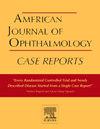Corneal pseudomicrocysts following claudin-6 antibody-drug conjugate infusion
Q3 Medicine
引用次数: 0
Abstract
Purpose
To report a case of bilateral corneal pseudomicrocysts associated with infusions of a novel antibody-drug conjugate targeting claudin-6, called TORL-1-23.
Observations
A 47-year-old female with a history of advanced recurrent serous ovarian cancer presented to a level 1 tertiary care center with ocular irritation, redness, tearing, and light sensitivity following two infusions of TORL-1-23. Patient's past ocular history was unremarkable. The patient was enrolled in a phase 1 clinical trial for TORL-1-23, an antibody-drug conjugate (ADC). Nine days following the second infusion the patient presented to the ophthalmology clinic complaining of two weeks of bilateral eye discomfort, tearing, and photophobia. On examination, the patient had decreased visual acuity with a surface keratopathy associated with a whorled pattern of epithelial pseudomicrocysts in both eyes. Corneal changes were concentrated between the inferior limbus and central cornea. The remainder of the ophthalmic exam was unremarkable. Collagen and silicone punctal plugs were placed and the patient was started on preservative free artificial tears, topical loteprednol 0.5 %, later replaced with topical prednisolone acetate 1 % drops, and brimonidine 0.2 % in both eyes. The patient developed neuropathy which necessitated a decrease in ADC dosage and the patient's symptoms subsequently improved. However, a decrease in visual acuity and increase in corneal pseudomicrocysts was seen after the fifth infusion. Corneal disease improved with the placement of new collagen punctal plugs and addition of cyclosporine 0.05 % eye drops in both eyes. Ocular symptoms and exam findings waxed and waned with continued infusions of the ADC.
Conclusions and importance
This case reports an incidence of corneal pseudomicrocysts associated with TORL-1-23 treatment, which should be recognized as a potential adverse effect of this novel therapy.
claudin-6抗体-药物偶联输注后角膜假微囊
目的报告一例双侧角膜假微囊肿与输注一种新型靶向cladin -6的抗体-药物偶联物TORL-1-23有关。患者47岁,女性,有晚期复发性浆液性卵巢癌病史,两次输注TORL-1-23后,因眼部刺激、红肿、流泪、光敏就诊于一级三级护理中心。患者既往眼部病史无明显变化。该患者参加了一项抗体-药物偶联物(ADC) TORL-1-23的1期临床试验。第二次输液后9天,患者到眼科诊所就诊,主诉两周的双眼不适、流泪和畏光。检查时,患者视力下降,伴有两眼表面角膜病变伴轮状上皮假微囊肿。角膜变化主要集中在下缘和中央角膜之间。眼科检查的其余部分一般。放置胶原蛋白和硅胶点塞,患者开始使用不含防腐剂的人工泪液,局部使用0.5%的洛特泼尼诺,随后用醋酸泼尼松龙1%滴剂和0.2%的溴莫尼定替代。患者出现神经病变,需要减少ADC剂量,患者的症状随后得到改善。然而,第5次注射后,视力下降,角膜假微囊增多。眼角膜病变在植入新的胶原点塞和添加0.05%环孢素滴眼液后得到改善。随着ADC的持续输注,眼部症状和检查结果忽好忽坏。结论和重要性:本病例报告了与TORL-1-23治疗相关的角膜假微囊的发生率,这应该被认为是这种新疗法的潜在不良反应。
本文章由计算机程序翻译,如有差异,请以英文原文为准。
求助全文
约1分钟内获得全文
求助全文
来源期刊

American Journal of Ophthalmology Case Reports
Medicine-Ophthalmology
CiteScore
2.40
自引率
0.00%
发文量
513
审稿时长
16 weeks
期刊介绍:
The American Journal of Ophthalmology Case Reports is a peer-reviewed, scientific publication that welcomes the submission of original, previously unpublished case report manuscripts directed to ophthalmologists and visual science specialists. The cases shall be challenging and stimulating but shall also be presented in an educational format to engage the readers as if they are working alongside with the caring clinician scientists to manage the patients. Submissions shall be clear, concise, and well-documented reports. Brief reports and case series submissions on specific themes are also very welcome.
 求助内容:
求助内容: 应助结果提醒方式:
应助结果提醒方式:


